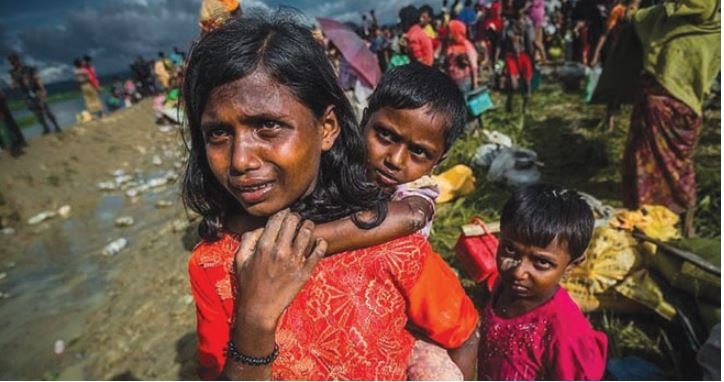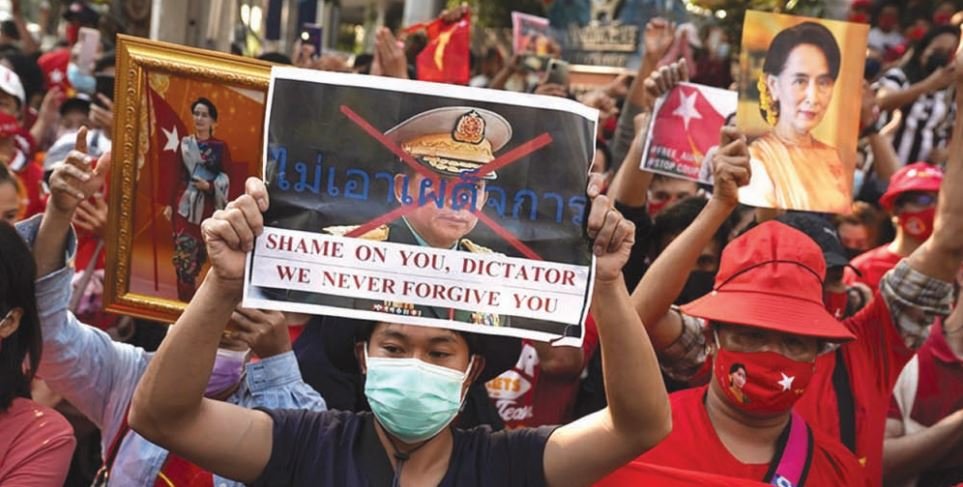February 2023 marks two years since the coup in Myanmar that entails the killing of almost 3 thousand civilians and almost 14 thousand being incarcerated by the military junta. The talk of holding a national election seems to be a desperate attempt to establish control and legitimacy for the military dictatorship. Nonetheless, more than a third of Myanmar’s townships are not in control of the military and thus, prevailing conditions are not conducive to holding a free and fair election. Rather, the conflict may take a more aggravated violent path with the ethnic armed organizations (EAOs) and People’s Defence Force (PDF) involved. Now the question is how did Myanmar get here? Whether ASEAN as one of the most successful regional groupings in the world could prevent such a fall? To find the answers to these questions one needs to look at the 2017 influx of Rohingyas from Myanmar to Bangladesh.
ROHINGYA PREDICAMENT
In the last decade, the withdrawal of the Western sanctions under the pretense of democratization of Myanmar coincided with the growing importance and centrality of ASEAN in the US foreign policy. Under the Obama administration, Washington has already rebalanced to counter China’s influence over the ASEAN nations. Nothing could be more convenient for the US policymakers than finding a self-isolated country that was apparently on a journey to embrace democracy.
You Can Also Read: IS BANGLADESH READY TO FACE ANY MORE WAR CRISIS?
What possibly made them most ecstatic was, this one was dependent on Beijing for decades. Momentary joy turned sour when the 2017 atrocities by the Tatmadaw triggered a mass influx of Rohingyas from the Rakhine state of Myanmar to Bangladesh under the pretext of a “clearance operation” against the Arakan Rohingya Salvation Army (ARSA). In the face of mass killings and persecution, almost a million Rohingyas fled their homes and crossed borders into Bangladesh. Later the United Nations termed it as a “textbook case of ethnic cleansing.”
ASEAN countries like Thailand, Malaysia, and Indonesia received a significant amount and steady stream of Rohingya refugees over the years who fled military atrocities and persecutions. Malaysia already has a refugee population of 100,000 Rohingyas registered with the UNHCR. Most of these Rohingya refugees reached the Malaysian shoreline by making their perilous journey through the Bay of Bengal and the Andaman sea between 2012 and 2015. Nonetheless, Thailand is receiving increasing preference from the Rohingya refugees as a transit point or hub before relocating to a third country. Another ASEAN country, Indonesia has seen relatively smaller numbers of Rohingyas in comparison to its other ASEAN neighbours. Besides the ASEAN Way, most of the member states not being the signatory of the 1951 refugee convention and their diverse level of governance system have been major stumbling blocks in dealing with the Rohingya crisis and Myanmar.

THE QUESTION OF ASEAN CONSENSUS AND CLEAVAGES
In the wake of the 2017 Rohingya influx, the lukewarm ASEAN response was heavily criticised. Hence, following the February Coup in 2021, the onus was on ASEAN to do something against the military junta of Myanmar to uphold human rights in a country that already persecuted a million to exile in Bangladesh. Under the scrutiny of the international community, a unified regional response was finally shaping up during the ASEAN Leaders’ Indonesia Meeting in April 2021. A Five-Point Consensus (5PC) was signed by the member states representatives, including Myanmar’s military junta, General Min Aung Hlaing to abate some international pressure. Consequently, as soon as the General returned to the Capital, Naypyidaw declared that Myanmar would implement the 5PC on its own timetable. In addition to that, the Association’s principle of noninterference undermines its capability to hold Myanmar accountable for its domestic matters. To make matter worse, on the Myanmar issue, there has been a split right down the middle among the ASEAN members. This split can be best summed up as “maritime ASEAN” vis-à-vis “ASEAN Mekong” countries. While “maritime ASEAN” consists of Indonesia, Malaysia, Brunei, Philippines and Singapore; the “Mekong ASEAN” comprises of Vietnam, Laos, Cambodia, Thailand and Myanmar. Maritime ASEAN countries have relatively mature political and governance systems. During the 2017 Rohingya influx, this group of countries manifested their concerns regarding the plight of the Rohingyas in the Rakhine state. Conversely, the Mekong ASEAN countries were reluctant to criticise the Tatmadaw or the Aung San Suu Kyi’s government for the persecution and atrocities committed against the Rohingyas in the Rakhine state.

The cleavages were much visible during an “informal” meeting hosted in Bangkok on 22nd December 2022 while the meeting was boycotted by the maritime ASEAN. The reason behind such an action was that the Thailand meeting undermined the ASEAN decision to exclude Myanmar representatives until the military regime shows some signs to adhere to the agreed 5PC. Furthermore, Thailand played a leadership role for “Mekong ASEAN” as it has developed a close relationship with Senior General Min Aung Hlaing. The extent of this warm relationship was visible during the meeting between General Chalermpol Srisawat, Chief of Thai Defence Forces and Senior General Min Aung Hlaing in Rakhine State on January 2023.
THE LIMITS OF THE ASEAN WAY
The ASEAN Way known to be the bedrock for ASEAN countries has further compounded the grouping’s efforts to abate the Rohingya crisis. As part of this cardinal rule, ASEAN has largely remained silent on the atrocities perpetrated on the Rohingya community and decided to take a modest stance against Myanmar citing its non-intervention principles. Consequently, ASEAN has been incessantly criticised for its inability to find a solution in the Rakhine state and thereby, failing to put any pressure on Naypyidaw to end the eviction of the Rohingyas. The principle of non-interference has always been termed as a hindrance in managing any meaningful cooperation within the ASEAN framework. In the case of Rohingya crisis, ASEAN’s principle of decision-making by consensus has severely limited organization’s role in the Rakhine state. Consequently, any step within the ASEAN framework regarding the political and legal aspects of the Rohingya will need Myanmar’s consent. This norm is famously known as ASEAN Way, which highlights the core value such as respect for sovereignty has been identified as a challenge for ASEAN to respond to a humanitarian crisis like Rohingya. The ASEAN Way, handicapped the organization’s capacity in responding to the atrocities committed by the Tatmadaw in the Rakhine state. Consequently, the dilemma between ASEAN’s responsibility and aspiration to safeguard the human rights of the Rohingyas and honouring the code not to intervene in the domestic affairs of Myanmar has undermined the credibility of ASEAN.

When Cambodia took over the chairmanship in 2022 many commentators expressed their apprehension regarding the ASEAN’s effectiveness to repatriate Rohingyas given Cambodia’s warm relationship with Myanmar. Jakarta’s term as the Chair of the Association in 2023 does not promise to offer any revolutionary change either as in January Indonesia clarified that it would not apply “megaphone diplomacy” to pressurise the military junta of Myanmar to implement ASEAN-prescribed regional roadmap to peace. Rather ASEAN will offer Myanmar military rulers to facilitate a national dialogue to end violence. Therefore, the priority for Indonesia as Chair of the ASEAN is to facilitate a national dialogue that will be inclusive with all the stakeholders, ending the violence and supplying humanitarian assistance to the people in need based on the 5PCs. Once critical of Myanmar’s unwillingness to follow the 5PCs, Indonesia seems to be following “soft diplomacy” in dealing with the military leadership of Myanmar as the number of Rohingyas fleeing Myanmar and taking shelter in the Aceh region has been increasing. Contrary to the Indonesian “soft approach”, during his visit to Thailand, Malaysian Prime Minister Anwar Ibrahim called for a tougher stance where the ASEAN “should be courageous enough to try and resolve this”. He believes, “It would be ideal if we have a strong consensus, and give a strong message to the Myanmar regime.” Furthermore, he called for the ASEAN to suggest and promote “a new mechanism to make sure that these atrocities committed, perpetrated against their own people must end.” Another stumbling block for the ASEAN prescribed 5PCs to be meaningful or functional is the absence of opposition forces in any discussion between ASEAN and Myanmar following the coup or the exodus of Rohingyas. The exclusion of Myanmar’s popular resistance, the National Unity Government (NUG) and the ethnic armed organizations (EAOs), extends the legitimacy of the military regime of Myanmar and undermines the acceptance of the 5PCs. In effect, the five-point plan lost its appeal as a roadmap to peace for both the military junta and the opposition forces of Myanmar.
ASEAN’S FLEETING CENTRALITY
Increasingly, ASEAN’s two core principles, non-interference and consensus, have made it impossible for this regional grouping to be relevant in the face of any humanitarian crisis. These two rules have worked wonderfully well to keep the domestic crisis of many of these poorly governed post-colonial member states at arm’s length and thereby facilitating economic growth. Hence, following the 2017 Rohingya influx, ASEAN member states were largely happy to let it go as one of Myanmar’s internal events. However, as time, ASEAN leaders are running out of patience with the Myanmar junta. On the non-interference ground, by failing to take any decisive punitive measures against the military regime of Myanmar, the regional block has been undermining the integrity of ASEAN and Southeast Asia’s regional stability. By compromising and giving legitimacy to the military regime, ASEAN has undermined the aspiration of the Rohingyas and other ethnic civilian populations of Myanmar. A continuous outflow of refugees from Myanmar and failure to manage transnational crimes emanating from this humanitarian crisis will eventually question the rationale for the existence of this regional block. Furthermore, given the priority of the Biden administration on human rights, the military regime’s representation in the ASEAN meetings will deter the US to take part. Consequently, Southeast Asian nations will be left to deal bilaterally with the US instead of under a formidable multilateral front. Indeed, a disadvantageous position for the relatively weak Southeast Asian countries who want their strategic autonomy to be protected without relying heavily either on the US or China. Therefore, any further legitimization of Myanmar’s military regime poses a serious regional security threat and to ASEAN’s centrality and geopolitical influence at large. The recent promulgation of the Burma Act 2021 further clarifies the American position that Washington will be steadfast in bringing down this military regime even if it requires assisting the opposition forces. Such a strong message put ASEAN in a tight spot to safeguard its influence and integrity within its region.


